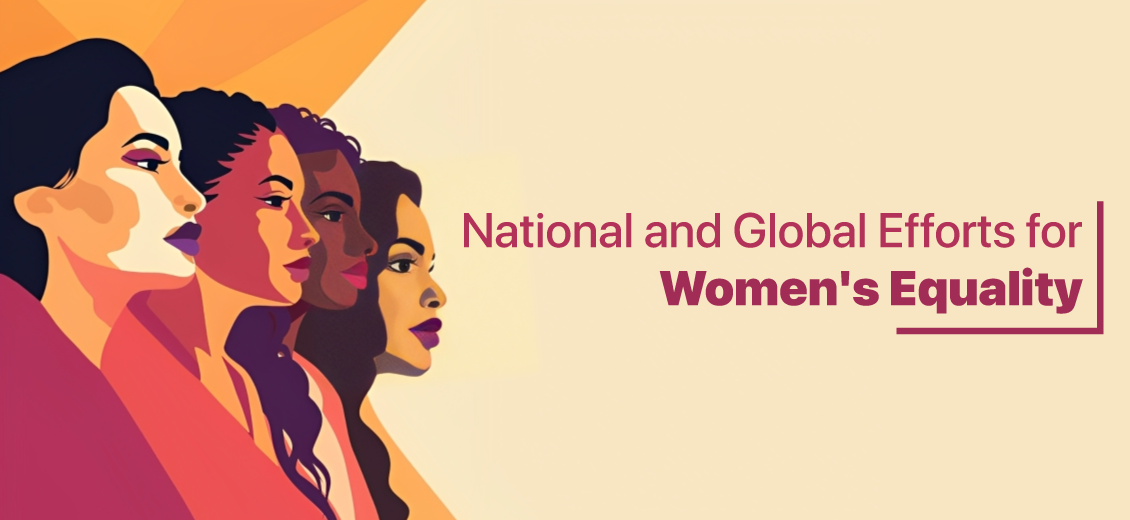National and Global Efforts for Women's Equality
Blogs Home
- 28 Aug 2023

The United States observes Women's Equality Day on August 26 to mark the adoption of the Nineteenth Amendment (also known as Amendment XIX) to the United States Constitution in 1920. This amendment forbids the states and the federal government from denying citizens of the United States the right to vote based on sex. Representative Bella Abzug (D-NY) first introduced a joint resolution to Congress in 1971 to proclaim August 26 as “Women’s Equality Day,” but the bill initially failed. Abzug reintroduced the bill in 1973 and it was eventually passed by the House and the Senate. In 1972, Richard Nixon became the first president to issue a proclamation designating August 26 as “Women’s Rights Day.” Every year since, the President has declared August 26 “Women’s Equality Day.”
The Idea of Women's Equality
The idea of Gender Equality is simple. It refers to equal rights, and opportunities for everyone, regardless of their gender. It is a recognition that every being is equal and deserves equal respect. Note that the idea of Gender Equality is wider than Women's equality. For this blog, I am solely focusing on Women's Equality.
Without ensuring the equality of women, a just and inclusive society is not possible for it requires no discrimination, or prejudice against anyone. The importance of ensuring the equality of women is underlined by the fact that development, be it political, economic, or social, is only possible when women have and exercise equal rights. A society can progress only when women and men share equal rights.
When one traces the long battle for the provision of equal rights, it can be discovered that the fight for women's rights has a long, illustrious history that dates back millennia. Women and their allies have been at the forefront of campaigning for change, from the suffrage campaigns that battled for women's ability to vote to the struggles to ensure equal pay and prevent gender-based violence. The women's rights movement in India gained momentum during the colonial era and persisted through many periods, resulting in substantial legislative and sociological changes.
National and Global Efforts for Women's Equality
The previous few decades have seen progress in terms of advocacy for women's empowerment. Since education and financial independence are two prime tools that are necessary to ensure the empowerment of women, various initiatives have been introduced to promote the same. This is done by schemes launched at both national and local levels.
Launched in 2015 by the Government of India, Beti Bachao, Beti Padhao, aimed to create awareness among the public regarding the need for girls' education. A scheme to benefit working women, the idea of working women hostels was implemented. Schemes like Ujjwala Yojana launched in 2016 which aims to provide 'smoke-free lives' to women are instrumental in ensuring social change and benefit the health of women. At the global level too, the idea of Equality is well understood and implemented. This is evident from the Sustainable Development Goal (SDG) 5 which aims to achieve gender equality and empower all women and girls. A sustainable world is unimaginable without ensuring the basic right of equality for all genders.
Gender Disparities and Challenges
In many areas of society, there are still gender gaps, which make it difficult for women to advance and develop. These differences are noticeable in a variety of fields, including work, health, and education. In addition, there are still many difficulties that women must overcome, from discrimination and abuse to the influence of ingrained social standards. Some of the prevalent forms of disparities and discrimination are:
- Lack of Education: An estimate done by UNESCO shows that 129 million girls are out of school. The reasons include poverty, gender bias against females, violence, child marriage, and exploitation. It's known that the chances of a girl stepping into a classroom are less than a boy.
- Poor Health: Social barriers that restrict women and girls from receiving the greatest healthcare and achieving optimal health include, uneven power relations between men and women, social norms that limit access to education and paid work, and a sole focus on the reproductive functions of women.
- Violence Against Women: A significant public health issue and a violation of women's human rights, violence against women, particularly against intimate partners and sexual assault, is on the rise. According to estimates made by the WHO, around one in three (30%) women worldwide have experienced physical and/or sexual intimate relationship abuse or non-partner sexual violence at some point in their lives.
- Gender Discrimination: Any exclusion or limitation based on gender that prevents girls, boys, women, and/or men from understanding, appreciating, or exercising their full and equal human rights is considered gender discrimination. Usually, this begins in childhood itself.
- Social Norms: Gender norms are social rules that set limits on how men, women, and children should behave in society and how their gender identities should be expressed. As an example, girls are significantly more prone than boys to engage in household chores. Girls constitute a majority, accounting for around two-thirds of all youngsters participating in domestic responsibilities for a minimum of 21 hours per week. This circumstance can have a detrimental impact on their academic achievements. Likewise, mirroring this situation, women are extensively engaged in domestic labour and offer unpaid caregiving to others for a duration ranging from two to ten times greater than the comparable commitment by men.
Women's Representation in Politics and Governance
The degree to which women participate in politics and positions of power varies depending on the level of government. Despite the advancements in the discourse on women's equality, women are still notably underrepresented, particularly at higher levels. To have effective governance, there must be a greater representation of women since this results in more inclusive policies that better serve the needs of the entire population.
As per the data provided by UN Women, only 26.5% of parliamentarians are women in the lower house. Just six countries have 50% or more representation in the Parliament. The same data reveals that if the trend continues, gender parity in the legislative bodies at the national level cannot be achieved before 2063. Women in leadership positions have been shown to improve the process of decision-making. This is evident from the results of Panchayats in India. UN Women shares research on panchayats (local councils) in India, which discovered that the number of drinking water projects in areas with women-led councils was 62% higher than in those with men-led councils.
Women's Economic Empowerment
There are multiple challenges for women in terms of their participation in the economy. Women are paid less than men for similar work. Further, they have a reduced chance of getting a loan or accessing any financial resources which acts as a constraint. Societal norms as well as double burden also act as a hindrance. In some cases, discriminatory laws may also constrain them from participating fully in economic activities.
On the brighter side, the scope of opportunities for women is now increasing. Women are stepping into business and becoming successful entrepreneurs. Entrepreneurship gives women the chance to earn money, accumulate assets, and contribute to economic growth, which promotes more independence. In terms of job creation, it's noted that Women-owned enterprises can give others access to jobs, boosting local economies in the process. Women who have achieved success as business owners challenge conventional gender norms and inspire others to pursue their aspirations. They introduce fresh perspectives and innovative concepts to the industry, contributing to the sector's growth and evolution.
By giving women the tools, they need to enter different industries, skill development programmes can increase their employability and financial potential. With certain skills and necessary training, they have been able to gain employment in different sectors and continue to step up the organisational ladder. Further, access to the digital world has opened a window of opportunity for those who cannot step out of their domestic lives.
International Best Practices
A summary brief published by the OECD (Organization for Economic Co-operation and Development), "Is the Last Mile the Longest?" highlights that the Nordic Countries- Denmark, Finland, Sweden, Iceland, and Norway, have been champions of gender equality both at work and at home. Countries like Rwanda where the women in parliament are highest in their percentage are good examples to ensure political participation. The practices adopted by these countries can be modified according to the Indian context and must be taken inspiration from to make gender equality possible. While a lot of work has been done in the education sector, there is still a need to push for girls' education and ensure safe healthcare access across states within India. Most importantly, the cultural and social norms that hinder the growth of women must be questioned.
International Frameworks and Commitments
Various frameworks and conventions have been adopted and ratified on a global level to promote the cause of women. Two of them are as follows:
- Convention on the Elimination of All Forms of Discrimination Against Women (CEDAW): Also known as the International Bill of Rights for Women, CEDAW consists of a Preamble and 30 articles that describe what is discrimination against women. It is a landmark convention that was adopted in 1979 by the United Nations General Assembly (UNGA). Notably, it is the only human rights treaty that affirms the reproductive rights of women. India ratified CEDAW in 1993.
- Beijing Declaration and Platform for Action: This is considered the most "progressive blueprint" for advancing the rights of women. It was a result of the Fourth World Conference on Women in 1995. The framework is focused on the goals of equality, development and peace for all women everywhere. India played a pivotal role in the adoption of this declaration too.
Future Challenges and the Way Forward
Traditional ideas and societal standards that uphold gender roles and stereotypes still stand in the way of equality. These are deep-rooted norms that must be understood, analysed, and challenged. Gender-based violence, harassment, and discrimination continue to be widespread problems that threaten the rights and well-being of women.
Several initiatives and policies can be put into place to promote women's empowerment. Preconceptions can be contested and equality to be promoted through gender-sensitive education curricula. Strengthened legislative changes should uphold equal rights while addressing violence and discrimination. Economic empowerment policies can effectively reduce financial disparities. Policies at work that support work-life balance, such as paid parental leave and flexible scheduling, are advantageous to both women and families. Improved access to healthcare is essential, especially for maternity and reproductive health.
Creating a more inclusive and equitable future for all requires effective cooperation between governments, civil society, the private sector, and individuals to bring a true transformation. It's also important to realise that the task we have at hand, to make a just and equitable world, is mammoth. It requires the efforts of the entire society. Every individual, including men, would need to work together to ensure a society that ensures women's equality. Fighting harmful conventions and behaviours requires involving men and boys in gender equality initiatives. And, as Kamla Bhasin once said, “Men of quality are not afraid of equality.”
Sources:
- https://blogs.loc.gov/manuscripts/2022/08/from-suffrage-day-to-womens-equality-day/
- https://www.niti.gov.in/empowerment-women-through-education-skilling-micro-financing
- https://pib.gov.in/PressReleasePage.aspx?PRID=1568243
- https://www.un.org/sustainabledevelopment/gender-equality/#:~:text=Goal%205%3A%20Achieve%20gender%20equality%20and%20empower%20all%20women%20and%20girls&text=Gender%20equality%20is%20not%20only,peaceful%2C%20prosperous%20and%20sustainable%20world.
- https://www.worldbank.org/en/topic/girlseducation
- https://www.who.int/health-topics/women-s-health
- https://www.who.int/news-room/fact-sheets/detail/violence-against-women
- https://www.savethechildren.org/us/charity-stories/how-gender-discrimination-impacts-boys-and-girls
- https://www.savethechildren.org/us/charity-stories/how-gender-norms-impact-boys-and-girls#:~:text=Gender%20norms%20are%20social%20principles,is%20considered%20to%20be%20appropriate.
- https://www.unwomen.org/en/what-we-do/leadership-and-political-participation/facts-and-figures
- https://www.un.org/womenwatch/daw/cedaw/#:~:text=The%20Convention%20on%20the%20Elimination,bill%20of%20rights%20for%20women.
- https://www.unwomen.org/en/digital-library/publications/2015/01/beijing-declaration
Annie Pruthi

Annie Pruthi is pursuing her masters in Pol. Science from JMI, New Delhi and is a 1st division Arts graduate from Gargi College, DU. She is an avid reader and an award-winning author.
Blogs Home



